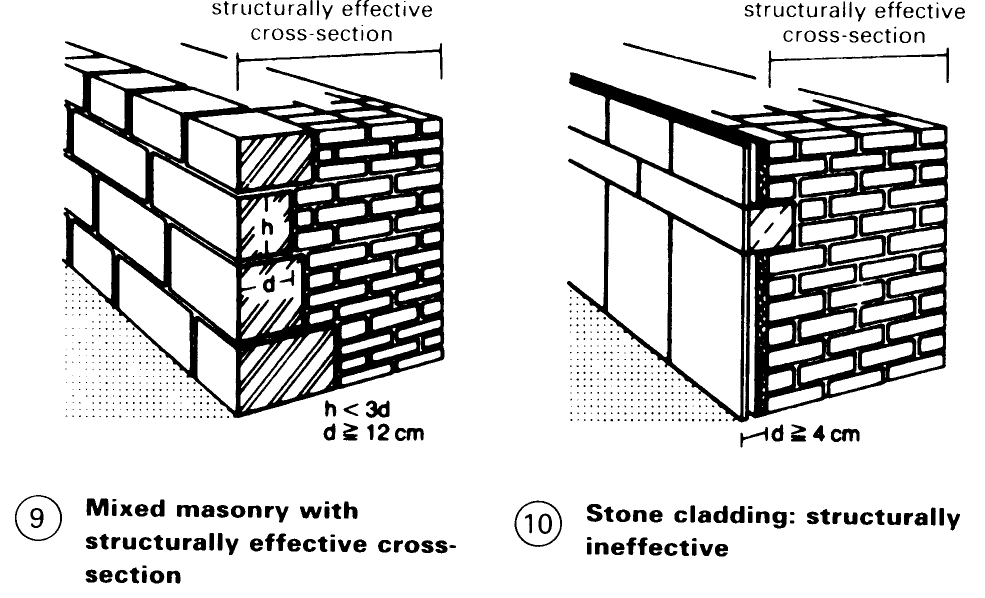Masonry. Natural Stone. Bricks and Blocks
Masonry in natural stone is referred to as random rubble, squared, dressed, ashlar, uncoursed, coursed, etc. - (1) - (10). Stone quarried from natural deposits should be laid in the orientation as found in the quarry - (1), (3), (4), to give an attractive and natural appearance; this is also better from a structural viewpoint, as the loading is mainly vertical in pressure between the courses. Igneous stone is suitable for random, uncoursed masonry (2).
The length of the stones should be four or five times their height, no more, and certainly no less than the stone height. The stones' size is of great significance to the scaling of a building. Attention must be paid to good bonding on both sides. In natural masonry, the bonding should show good craftsmanship across the whole cross-section.


The following guidelines should be observed:
(a) Nowhere on the front and rear faces should more than three joints run into each other.
(b) No butt joint should run through more than two courses.
(c) There must be a minimum of one header on two- stretcher courses, or the header and stretcher courses should alternate with one other.
(d) The depth of the header must be approx. 1.5 times the height of a course and not less than 300mm.
(e) The stretcher depth must be approx, equal to the course height.
(f) The overlap of the butt joints must be >100 mm (masonry courses) and 150mm on ashlar walling - (5)- (7).
(g) The largest stones should be built in at the corners. (1)- (6). The visible surfaces should be subsequently pointed.


The masonry should be levelled and trued for structural bearing every 1.5-2.0m (scaffold height). The mortar joints should be 120mm - (9). Front facing (cladding) of 25-50mm thickness (Travertine, limestone, granite, etc.) is not included in the cross-section and the facing is anchored to the masonry with noncorroding tie-rods, with a 2mm separation from it – (10).

Bricks and Blocks. As per BS 6100: Section 5.3: 1984, masonry units include several terms: unit (special, shaped, standard shaped, cant, plinth, bullnose, squint, solid, cellular, hollow, perforated, common, facing, split-faced, lintel, fixing, concrete, calcium silicate, sandlime, flintlime, fired-clay, terracotta, faience), header, stretcher, closer (king, queen) and air brick. Brick: a masonry unit not over 338mm in length, 225mm in width or 113mm in height.

The term 'brick' includes engineering, frogged, hand-made, stock, wire-cut, rusticated, rubber, tile and damp proof course bricks. Block: a masonry unit exceeding the size of any dimension of brick, including dense concrete, lightweight concrete, lightweight aggregate concrete, aerated concrete, autoclaved aerated concrete, thermal insulation, foam-filled concrete, clinker, dry walling, cavity closer and quoin blocks. All masonry work must be horizontally and vertically true, and properly aligned in accordance with regulations. On double leafed masonry – (7) + (9), floors and roof must be supported only by the inner leaf. Masonry leafs should be joined with a min. of 5 stainless steel wire ties, 3mm in diameter, per sq. m. The ties are separated 250mm vertically and 750mm horizontally.
Masonry walling has to be braced with lateral walls and the tops restrained by upper floors (cellular principle). Bracing walls are plate-like components which stiffen the structure against buckling - p. 63 (14). They are rated as supporting walls if they carry more than their own weight from one storey. Non-supporting walls are plate-like components which are stressed only by their own weight and do not provide buckling support.

Recesses and slots have to be cut out or positioned in the masonry bonds. Horizontal and slanting recesses are permitted, but with a slenderness ratio of < 140mm and thickness > 240mm under special requirements - p. 63 (15). Ties should be provided for connection between external walls and partition walls acting as bracing walls that transmit horizontal loads. Horizontal reinforcement is required in structures of more than two complete storeys or which are more than 18[t]m long, if the site conditions demand it, or where there are walls with many or large openings (if the sum of the opening widths is more than 60% of the wall length, or where the window width is over 2/з of the storey height or more than 40% of the wall length).

Date added: 2023-01-01; views: 625;
